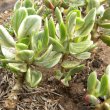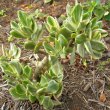Crassula ovata variegata
| Botanical Name | Crassula ovata variegata |
|||||||||||
| Family | Crassulaceae - The crassula family. |
|||||||||||
| Pronunciation | KRASS-yoo-la oh-VAY-tuh var-ee-GAY-tuh |
|||||||||||
| Common Name(s) |
English: Jade plant - varigated cultivar 'Tricolor'
|
|||||||||||
| Plant Group |
|
|||||||||||
| Plant Size |
|
|||||||||||
| Position |
|
|||||||||||
| General Information |
|
|||||||||||
| Specific Information | In dry conditions this crassula performs better with at least some shade. It tolerates dry conditions but growth rate is reduced. |
|||||||||||
| Ad Break | ||||||||||||
| Flowers | ||||||||||||
| Description | tiny star flowers in tight clusters |
|||||||||||
| Season |
|
|||||||||||
| Colour |
|
|||||||||||
| Growth Rate |
|
|||||||||||
| Plant Uses |
|
|||||||||||
| Distribution and Habitat | cultivar |
|||||||||||
| Planting Suggestions | Plant in a well-drained garden soil with a good dressing of compost and mulch well to retain moisture. This crassula does not seem to be quite as tough as the plain Crassula ovata and needs a little more moisture. |
|||||||||||
| Medicinal Uses | Not applicable |
|||||||||||
| Ad Break | ||||||||||||
Author: Lorraine Solomon






Discuss this plant
Share knowledge, ask a question or give an experience.